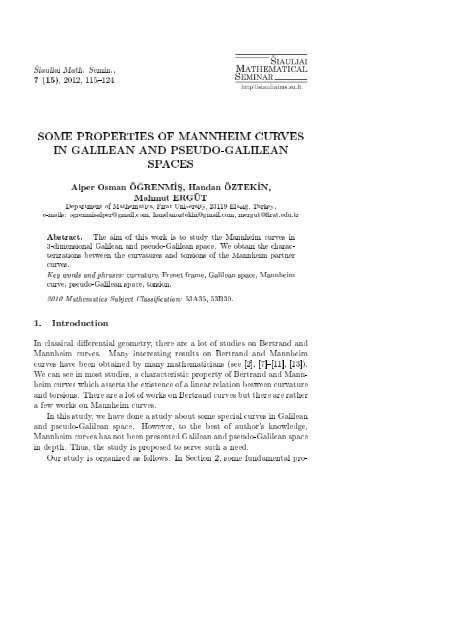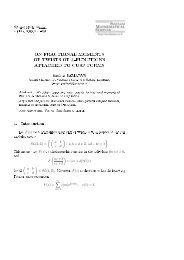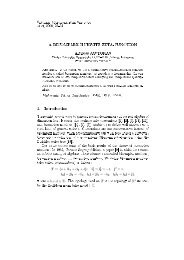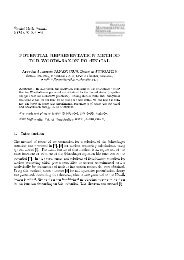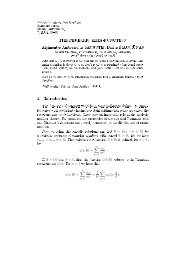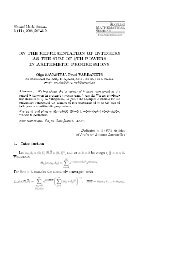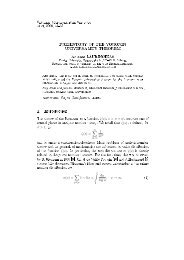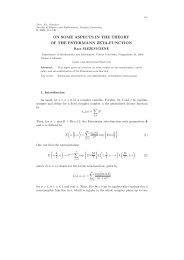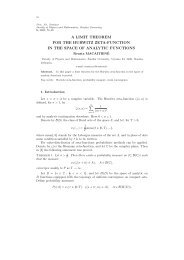some properties of mannheim curves in galilean and pseudo ...
some properties of mannheim curves in galilean and pseudo ...
some properties of mannheim curves in galilean and pseudo ...
You also want an ePaper? Increase the reach of your titles
YUMPU automatically turns print PDFs into web optimized ePapers that Google loves.
’iauliai Math. Sem<strong>in</strong>.,7 (15), 2012, 115124SOME PROPERTIES OF MANNHEIM CURVESIN GALILEAN AND PSEUDO-GALILEANSPACESAlper Osman Ö‡RENM “, H<strong>and</strong>an ÖZTEK N,Mahmut ERGÜTDepartment <strong>of</strong> Mathematics, Frat University, 23119 Elaz§, Turkey;e-mails: ogrenmisalper@gmail.com, h<strong>and</strong>anoztek<strong>in</strong>@gmail.com, mergut@rat.edu.trAbstract. The aim <strong>of</strong> this work is to study the Mannheim <strong>curves</strong> <strong>in</strong>3-dimensional Galilean <strong>and</strong> <strong>pseudo</strong>-Galilean space. We obta<strong>in</strong> the characterizationsbetween the curvatures <strong>and</strong> torsions <strong>of</strong> the Mannheim partner<strong>curves</strong>.Key words <strong>and</strong> phrases: curvature, Frenet frame, Galilean space, Mannheimcurve, <strong>pseudo</strong>-Galilean space, torsion.2010 Mathematics Subject Classication: 53A35, 53B30.1. IntroductionIn classical dierential geometry, there are a lot <strong>of</strong> studies on Bertr<strong>and</strong> <strong>and</strong>Mannheim <strong>curves</strong>. Many <strong>in</strong>terest<strong>in</strong>g results on Bertr<strong>and</strong> <strong>and</strong> Mannheim<strong>curves</strong> have been obta<strong>in</strong>ed by many mathematicians (see [2], [7][11], [13]).We can see <strong>in</strong> most studies, a characteristic property <strong>of</strong> Bertr<strong>and</strong> <strong>and</strong> Mannheim<strong>curves</strong> which asserts the existence <strong>of</strong> a l<strong>in</strong>ear relation between curvature<strong>and</strong> torsions. There are a lot <strong>of</strong> works on Bertr<strong>and</strong> <strong>curves</strong> but there are rathera few works on Mannheim <strong>curves</strong>.In this study, we have done a study about <strong>some</strong> special <strong>curves</strong> <strong>in</strong> Galilean<strong>and</strong> <strong>pseudo</strong>-Galilean space. However, to the best <strong>of</strong> author's knowledge,Mannheim <strong>curves</strong> has not been presented Galilean <strong>and</strong> <strong>pseudo</strong>-Galilean space<strong>in</strong> depth. Thus, the study is proposed to serve such a need.Our study is organized as follows. In Section 2, <strong>some</strong> fundamental pro-
116 A. O. Ö§renmi³, H. Öztek<strong>in</strong>, M. Ergütperties <strong>of</strong> Galilean <strong>and</strong> <strong>pseudo</strong>-Galilean space are given which will be used <strong>in</strong>the later sections. In Section 3, we give <strong>some</strong> characterizations <strong>of</strong> Mannheim<strong>curves</strong> <strong>in</strong> Galilean space. We also give <strong>some</strong> <strong>properties</strong> <strong>of</strong> Mannheim <strong>curves</strong><strong>in</strong> <strong>pseudo</strong>-Galilean space <strong>in</strong> Section 4.2. Prelim<strong>in</strong>ariesThe Galilean space is a three dimensional complex projective space P 3 <strong>in</strong>which the absolute gure {w, f, I 1 , I 2 } consists <strong>of</strong> a real plane w (the absoluteplane), a real l<strong>in</strong>e f ⊂ w (the absolute l<strong>in</strong>e) <strong>and</strong> two complex conjugate po<strong>in</strong>tsI 1 , I 2 ∈ f (the absolute po<strong>in</strong>ts).We shall take, as a real model <strong>of</strong> the space G 3 , a real projective spaceP 3 with the absolute {w, f} consist<strong>in</strong>g <strong>of</strong> a real plane w ⊂ G 3 <strong>and</strong> a reall<strong>in</strong>e f ⊂ w on which an elliptic <strong>in</strong>volution ε has been dened.We <strong>in</strong>troducehomogeneous coord<strong>in</strong>ates <strong>in</strong> G 3 <strong>in</strong> such a way that the absolute plane w isgiven by x 0 = 0, the absolute l<strong>in</strong>e f by x 0 = x 1 = 0 <strong>and</strong> elliptic <strong>in</strong>volutionby (x 0 : x 1 : x 2 : x 3 ) = (1 : x : y : z), the distance between the po<strong>in</strong>tsP i = (x i , y i , z i ), i = 1, 2, is dened by{|x 2 − x 1 | if x 1 ≠ x 2 ,d(P 1 , P 2 ) = √(y2 − y 1 ) 2 + (z 2 − z 1 ) 2 if x 1 = x 2 .Let α be a curve <strong>in</strong> G 3 dened by the arc length α : I → G 3 <strong>and</strong>parametrized by the <strong>in</strong>variant parameter s ∈ I, given <strong>in</strong> the coord<strong>in</strong>ate formα(s) = (s, y(s), z(s)).Then the curvature κ(s) <strong>and</strong> the torsion τ(s) are dened by√κ(s) = y ′′2 (s) + z ′′2 (s),τ(s) = det(α′ (s), α ′′ (s), α ′′′ (s))κ 2 ,(s)<strong>and</strong> associated mov<strong>in</strong>g trihedron is given byT (s) = α ′ (s) = (1, y ′ (s), z ′ (s)),N(s) =1κ(s) α′′ (s) = 1κ(s) (0, y′′ (s), z ′′ (s)),B(s) =1κ(s) (0, −z′′ (s), y ′′ (s)).
Some <strong>properties</strong> <strong>of</strong> Mannheim <strong>curves</strong>... 117The vectors T, N, B are called the vectors <strong>of</strong> the tangent, pr<strong>in</strong>cipal normal<strong>and</strong> b<strong>in</strong>ormal l<strong>in</strong>e <strong>of</strong> α, respectively. For their derivatives, the follow<strong>in</strong>gFrenet formulas holdT ′ (s) = κ(s)N(s),N ′ (s) = τ(s)B(s),B ′ (s) = −τ(s)N(s).More about the Galilean geometry can be found <strong>in</strong> [12].The <strong>pseudo</strong>-Galilean geometry is one <strong>of</strong> the real Cayley-Kle<strong>in</strong> geometries(<strong>of</strong> projective signature (0, 0, +, −) expla<strong>in</strong>ed <strong>in</strong> [3]. The absolute <strong>of</strong> the<strong>pseudo</strong>-Galilean geometry is an ordered triple {w, f, I}, where w is the ideal(absolute) plane, f is the l<strong>in</strong>e <strong>in</strong> w, <strong>and</strong> I is the xed hyperbolic <strong>in</strong>volution<strong>of</strong> po<strong>in</strong>ts <strong>of</strong> f.As <strong>in</strong> [3], <strong>pseudo</strong>-Galilean scalar product can be written as{x 1 x 2 if x 1 ≠ 0 or x 2 ≠ 0,⟨v 1 , v 2 ⟩ =y 1 y 2 − z 1 z 2 if x 1 = 0 <strong>and</strong> x 2 = 0,where v 1 = (x 1 , y 1 , z 1 ), v 2 = (x 2 , y 2 , z 2 ).It leaves <strong>in</strong>variant the <strong>pseudo</strong>-Galilean norm <strong>of</strong> the vector v = (x, y, z)dened by{x if x ≠ 0,∥v∥ = √|y 2 − z 2 | if x = 0.A vector v = (x, y, z) is said to be non-isotropic if x ≠ 0. All unit nonisotropicvectors are <strong>of</strong> the form (1, y, z). For isotropic vectors, x = 0 holds.There are four types <strong>of</strong> isotropic vectors: spacelike (y 2 − z 2 > 0), timelike(y 2 − z 2 < 0) <strong>and</strong> two types <strong>of</strong> lightlike (y = ±z) vectors. A non-lightlikeisotropic vector is a unit vector if y 2 − z 2 = ±1.Let α : I −→ G 1 3 , I ⊂ R, be a curve given byα(t) = (x(t), y(t), z(t)),where x(t), y(t), z(t) ∈ C 3 (the set <strong>of</strong> three times cont<strong>in</strong>uously dierentiablefunctions), <strong>and</strong> t runs through a real <strong>in</strong>terval [3].A curve α(t) <strong>in</strong> G 1 3 is said to be admissible curve if x′ (t) ≠ 0 [3].The <strong>curves</strong> <strong>in</strong> G 1 3 are characterized as follows [4][5].Type I. Let α be an admissible curve <strong>in</strong> G 1 3 parametrized by arc lengtht = s, <strong>and</strong> given <strong>in</strong> coord<strong>in</strong>ate formα(s) = (s, y(s), z(s)).
118 A. O. Ö§renmi³, H. Öztek<strong>in</strong>, M. ErgütThen the curvature κ α (s) <strong>and</strong> the torsion τ α (s) are dened byκ α (s) =√ ∣∣y ′′2 (s) − z ′′2 (s) ∣ ∣,τ α (s) = det(α′ (s), α ′′ (s), α ′′′ (s))κ 2 ,α(s)<strong>and</strong> the associated mov<strong>in</strong>g trihedron is given byT α (s) = α ′ (s) = (1, y ′ (s), z ′ (s))N α (s) =1κ α (s) α′′ (s) = 1κ α (s) (0, y′′ (s), z ′′ (s)),B α (s) =1κ α (s) (0, z′′ (s), y ′′ (s)).The vectors T α , N α , B α are called the vectors <strong>of</strong> the tangent, pr<strong>in</strong>cipalnormal <strong>and</strong> b<strong>in</strong>ormal l<strong>in</strong>e <strong>of</strong> α, respectively. For their derivatives the follow<strong>in</strong>gFrenet formulas holdT α(s) ′ = κ α (s)N α (s),N α(s) ′ = τ α (s)B α (s),B α(s) ′ = τ α (s)N α (s).Type II. Let β be an admissible curve <strong>in</strong> G 1 3s, <strong>and</strong> given <strong>in</strong> coord<strong>in</strong>ate formparametrized by arc lengthβ(s) = (s, y(s), 0).Then the curvature κ β (s) <strong>and</strong> the torsion τ β (s) are dened byκ β (s) = y ′′ (s),τ β (s) = a′ 2 (s)a 3 (s) ,<strong>and</strong> the associated mov<strong>in</strong>g trihedron is given bywhere, y, a 2 , a 3 ∈ C ∞ , s ∈ I ⊆ R.T β (s) = (1, y ′ (s), 0),N β (s) = (0, a 2 (s), a 3 (s)),B β (s) = (0, a 3 (s), a 2 (s)),
Some <strong>properties</strong> <strong>of</strong> Mannheim <strong>curves</strong>... 119The vectors T β , N β , B β are called the vectors <strong>of</strong> the tangent, pr<strong>in</strong>cipalnormal <strong>and</strong> b<strong>in</strong>ormal l<strong>in</strong>e <strong>of</strong> β, respectively. For their derivatives, the follow<strong>in</strong>gFrenet formulas holdT β ′ (s) = κ β(s)(cosh ϕ(s)N β (s) − s<strong>in</strong>h ϕ(s)B β (s)),N β ′ (s) = τ β(s)B β (s),B β ′ (s) = τ β(s)N β (s), (2.1)where ϕ(s) is the angle between a(s) = (0, a 2 (s), a 3 (s)) <strong>and</strong> the plane z = 0.3. Mannheim <strong>curves</strong> <strong>in</strong> Galilean spaceDef<strong>in</strong>ition 3.1. Let α <strong>and</strong> α 1 be <strong>curves</strong> <strong>in</strong> 3-dimensional Galilean space G 3 .If there exists a correspond<strong>in</strong>g relationship between the space <strong>curves</strong> α <strong>and</strong>α 1 such that, at the correspond<strong>in</strong>g po<strong>in</strong>ts <strong>of</strong> the <strong>curves</strong>, the pr<strong>in</strong>cipal normall<strong>in</strong>es <strong>of</strong> α co<strong>in</strong>cide with the b<strong>in</strong>ormal l<strong>in</strong>es <strong>of</strong> α 1 , then α is called a Mannheimcurve <strong>and</strong> α 1 is called a Mannheim partner curve <strong>of</strong> α. The pair {α, α 1 } issaid to be a Mannheim pair [6].Remark 3.2. Let α be a curve <strong>in</strong> Galilean space G 3 . Then α is Mannheimcurve if <strong>and</strong> only if its curvature κ α <strong>and</strong> torsion τ α satisfy the relation κ α =cτ 2 α for <strong>some</strong> constant c [10].Theorem 3.3. Let α be a Mannheim curve <strong>in</strong> Galilean space G 3 . Then α 1is the Mannheim partner curve <strong>of</strong> α. Then the curvature κ 1 <strong>and</strong> the torsionτ 1 <strong>of</strong> α 1 satisfy the equationfor <strong>some</strong> nonzero constant λ.τ ′ 1 = κ 1λ (λ2 τ 2 1 + 1)Pro<strong>of</strong>. Suppose that α(s) is a Mannheim curve <strong>in</strong> Galilean space G 3 . Thenwe can writeα(s 1 ) = α 1 (s 1 ) + λ(s 1 )B 1 (s 1 ) (3.1)for <strong>some</strong> function λ(s 1 ). By tak<strong>in</strong>g derivative <strong>of</strong> (3.1) with respect to s 1 <strong>and</strong>us<strong>in</strong>g the Frenet equations <strong>in</strong> Galilean space G 3 , we getT dsds 1= T 1 + λ ′ B 1 − λτ 1 N 1 .S<strong>in</strong>ce B 1 is co<strong>in</strong>cident with N, we obta<strong>in</strong>λ ′ (s 1 ) = 0,
120 A. O. Ö§renmi³, H. Öztek<strong>in</strong>, M. Ergütthat means that λ is nonzero constant. Thus, we haveOn the other h<strong>and</strong>, we haveT dsds 1= T 1 − λτ 1 N 1 . (3.2)T = T 1 cos θ + N 1 s<strong>in</strong> θ, (3.3)where θ is the angle between T <strong>and</strong> T 1 at the correspond<strong>in</strong>g po<strong>in</strong>ts <strong>of</strong> α <strong>and</strong>α 1 . Dierentiat<strong>in</strong>g <strong>of</strong> (3.3) with respect to s 1 , we getκN dsds 1= −T 1 θ ′ s<strong>in</strong> θ + κ 1 N 1 cos θ + N 1 θ ′ cos θ + τ 1 B 1 s<strong>in</strong> θ,κN dsds 1= −T 1 θ ′ s<strong>in</strong> θ + N 1 (κ 1 + θ ′ ) cos θ + τ 1 B 1 s<strong>in</strong> θ.S<strong>in</strong>ce {α, α 1 } is a Mannheim pair, we obta<strong>in</strong>κ 1 + θ ′ = 0,<strong>and</strong>, therefore, we haveθ ′ = −κ 1 . (3.4)From (3.2) <strong>and</strong> (3.3), we nd thatλτ 1 = − tan θ. (3.5)By tak<strong>in</strong>g derivative <strong>of</strong> this last equation <strong>and</strong> apply<strong>in</strong>g (3.4), we obta<strong>in</strong>If we consider (3.4) <strong>and</strong> (3.5) <strong>in</strong> (3.6), we getHence, the pro<strong>of</strong> is completed.λτ ′ 1 = −θ ′ (1 + tan 2 θ). (3.6)τ ′ 1 = κ 1λ (λ2 τ 2 1 + 1).Proposition 3.4. Let α be a Mannheim curve <strong>in</strong> Galilean space G 3 <strong>and</strong> α 1be the Mannheim partner curve <strong>of</strong> α. If α is a generalized helix, then α 1 is aplanar curve.
Some <strong>properties</strong> <strong>of</strong> Mannheim <strong>curves</strong>... 121Pro<strong>of</strong>. Let T, N, B be the tangent, pr<strong>in</strong>cipal normal <strong>and</strong> b<strong>in</strong>ormal vectoreld <strong>of</strong> the curve α, respectively. From the <strong>properties</strong> <strong>of</strong> generalized helix<strong>and</strong> the denition <strong>of</strong> Mannheim <strong>curves</strong> <strong>in</strong> Galilean space G 3 , we have<strong>and</strong>κ < N, P >= 0κ < B 1 , P >= 0for a constant direction P <strong>in</strong> Galilean space G 3 . Then it is easy to obta<strong>in</strong>that τ 1 = 0.4. Mannheim <strong>curves</strong> <strong>in</strong> <strong>pseudo</strong>-Galilean spaceDef<strong>in</strong>ition 4.1. Let α <strong>and</strong> α 1 be an admissible <strong>curves</strong> dened <strong>in</strong> Type Iwith nonzero κ α , τ α , s ∈ I <strong>in</strong> <strong>pseudo</strong>-Galilean space <strong>and</strong> {T α , N α , B α } <strong>and</strong>{T α1 , N α1 , B α1 } be the Frenet frame <strong>in</strong> <strong>pseudo</strong>-Galilean space G 1 3 along α<strong>and</strong> α 1 , respectively. If there exists a correspond<strong>in</strong>g relations between theadmissible <strong>curves</strong> α <strong>and</strong> α 1 such that, at the correspond<strong>in</strong>g po<strong>in</strong>ts <strong>of</strong> theadmissible <strong>curves</strong>, pr<strong>in</strong>cipal normal l<strong>in</strong>es N α <strong>of</strong> α co<strong>in</strong>cides with the b<strong>in</strong>ormall<strong>in</strong>es B α1 <strong>of</strong> α 1 , then α is called an admissible Mannheim <strong>curves</strong> <strong>and</strong> α 1 iscalled an admissible Mannheim partner curve <strong>of</strong> α. The pair {α, α 1 } is saidto be an admissible Mannheim pair <strong>in</strong> <strong>pseudo</strong>-Galilean space G 1 3 [1].Theorem 4.2. Let α an admissible curve dened <strong>in</strong> Type I <strong>in</strong> <strong>pseudo</strong>-Galilean space G 1 3 . Then α is an admissible Mannheim curve if <strong>and</strong> onlyif its curvature κ α <strong>and</strong> torsion τ α satisfy the relation κ α = −cτα 2 for <strong>some</strong>constant c.Pro<strong>of</strong>. Let α = α(s) be an admissible Mannheim curve. Let us denote by{T α , N α , B α } the Frenet frame eld <strong>of</strong> α.Assume that α 1 = α 1 (s 1 ) is an admissible curve whose b<strong>in</strong>ormal directionco<strong>in</strong>cides with the pr<strong>in</strong>cipal normal <strong>of</strong> α. Namely let us denote by{T α1 , N α1 , B α1 } the Frenet frame eld <strong>of</strong> α 1 . Then B α1 (s 1 ) = ± N α (s).The curve α 1 is parametrized by arc length s asα 1 (s) = α(s) + λ(s)N α (s) (4.1)for <strong>some</strong> function λ(s) ≠ 0. Dierentiat<strong>in</strong>g (4.1) with respect to s, we ndα ′ 1 = T α + λ ′ N α + λτ α B α .
122 A. O. Ö§renmi³, H. Öztek<strong>in</strong>, M. ErgütS<strong>in</strong>ce the b<strong>in</strong>ormal direction <strong>of</strong> α 1 co<strong>in</strong>cides with the pr<strong>in</strong>cipal normal <strong>of</strong> α,we have λ ′ = 0. Hence, λ is constant. The second derivative α 1 ′′ with respectto s isα 1 ′′ = (κ α + λτα)N 2 α + λτ αB ′ α .S<strong>in</strong>ce N α is <strong>in</strong> the b<strong>in</strong>ormal direction <strong>of</strong> α 1 , we haveκ α + λτ 2 α = 0.Conversely, let α be an admissible curve. Then the curvehas b<strong>in</strong>ormal direction N α .α 1 (s) = α(s) + λN α (s)Theorem 4.3. Let β an admissible curve dened <strong>in</strong> Type II <strong>in</strong> <strong>pseudo</strong>-Galilean space G 1 3 . Then β is an admissible Mannheim curve if <strong>and</strong> only ifits curvature κ β <strong>and</strong> torsion τ β satisfy the relation κ β =−ccosh ϕ τ β 2 for <strong>some</strong>constant c.Pro<strong>of</strong>. If we consider equations (2.1) <strong>and</strong> pro<strong>of</strong> <strong>of</strong> the Theorem 4.2. wecan prove the theorem easily.Theorem 4.4. Let α be an admissible Mannheim curve dened by Type I<strong>in</strong> <strong>pseudo</strong>-Galilean space G 1 3 . Then α 1 is the admissible Mannheim partnercurve <strong>of</strong> α. Then the curvature κ 1 <strong>and</strong> the torsion τ 1 <strong>of</strong> α 1 satisfy the follow<strong>in</strong>gequationτ ′ 1 = κ 1λ (λ2 τ 2 1 − 1)for <strong>some</strong> nonzero constant λ.Pro<strong>of</strong>. It is similar to a pro<strong>of</strong> <strong>of</strong> Theorem 3.3.Remark 4.5. By a simple parameter transformation, the conditioncan be written asτ ′ 1 = κ 1λ (λ2 τ 2 1 − 1)τ 1 = − ε ∫ (ελ tanκ 1 ds + c 0).Therefore, for each admissible Mannheim curve <strong>in</strong> <strong>pseudo</strong>-Galilean space G 1 3 ,there is an unique Mannheim partner curve.This reality is true for Mannheim curve <strong>in</strong> Galilean space G 3 .
Some <strong>properties</strong> <strong>of</strong> Mannheim <strong>curves</strong>... 123Proposition 4.6. Let α be an admissible Mannheim curve <strong>in</strong> <strong>pseudo</strong>-Galileanspace G 1 3 <strong>and</strong> α 1 be the admissible Mannheim partner curve <strong>of</strong> α. If α is ageneralized helix, then α 1 is a planar curve.Pro<strong>of</strong>. Let T, N, B be the tangent, pr<strong>in</strong>cipal normal <strong>and</strong> b<strong>in</strong>ormal vectoreld <strong>of</strong> the curve α, respectively. From the <strong>properties</strong> <strong>of</strong> generalized helix<strong>and</strong> the denition <strong>of</strong> admissible Mannheim <strong>curves</strong> <strong>in</strong> <strong>pseudo</strong>-Galilean spaceG 1 3 , we have κ < N, P >= 0<strong>and</strong>κ < B 1 , P >= 0for a constant direction P <strong>in</strong> <strong>pseudo</strong>-Galilean space G 1 3 . Then it is easy toobta<strong>in</strong> that τ 1 = 0.References[1] M. Akyi§it, A. Z. Azak, M. Tosun, Admissible Mannheim <strong>curves</strong> <strong>in</strong> <strong>pseudo</strong>-Galilean space G 1 3, African Diaspora J. Math., 10(2), 5865 (2010).[2] M. P. do Carmo, Dierential Geometry <strong>of</strong> Curves <strong>and</strong> Surfaces, Pearson Education,N. J., 1976.[3] B. Divjak, Curves <strong>in</strong> <strong>pseudo</strong>-Galilean geometry, Ann. Univ. Sci. Budapest.Eötvös, Sect. Math., 41, 117128 (1998).[4] B. Divjak, Z. M. Sipus, Special <strong>curves</strong> on ruled surfaces <strong>in</strong> Galilean <strong>and</strong><strong>pseudo</strong>-Galilean spaces, Acta Math. Hungar., 98(3), 203215 (2003).[5] B. Divjak, Z. M. Sipus, M<strong>in</strong>d<strong>in</strong>g i<strong>some</strong>tries <strong>of</strong> ruled surfaces <strong>in</strong> <strong>pseudo</strong>-Galilean space, J. Geometry, 77, 3547 (2003).[6] S. Ersoy, M. Akyi§it, M. Tosun, A note on admissible Mannheim <strong>curves</strong> <strong>in</strong>Galilean space G 3 , Math. Comb<strong>in</strong>., Book Ser., 1, 8893 (2011).[7] M. Külahc, M. Ergüt, Bertr<strong>and</strong> <strong>curves</strong> <strong>of</strong> AW (k)-type <strong>in</strong> Lorentzian space,Nonl<strong>in</strong>ear Anal., 70(4), 17251731 (2009).[8] H. Liu, F. Wang, Mannheim partner <strong>curves</strong> <strong>in</strong> 3-space, J. Geometry, 88,120126 (2008).[9] K. Orbay, E. Kasap, On Mannheim partner <strong>curves</strong> <strong>in</strong> E 3 , Intern. J. <strong>of</strong> PhysicalScien., 4(5), 261264 (2009).
124 A. O. Ö§renmi³, H. Öztek<strong>in</strong>, M. Ergüt[10] A. O. Ö§renmi³, H. Öztek<strong>in</strong>, M. Ergüt, Bertr<strong>and</strong> <strong>curves</strong> <strong>in</strong> Galilean space<strong>and</strong> their characterizations, Kragujevac J. Math., 32, 139147 (2009).[11] H. B. Öztek<strong>in</strong>, M. Ergüt, Null Mannheim <strong>curves</strong> <strong>in</strong> the M<strong>in</strong>kowski 3-spaceE13, Turk. J. Math., 34, 18 (2010).[12] O. Röschel, Die Geometrie des Galileischen Raumes, Habilitionsschrift,Leoben, 1984.[13] M. Yildirim Yilmaz, M. Bekta³, General <strong>properties</strong> <strong>of</strong> Bertr<strong>and</strong> <strong>curves</strong> <strong>in</strong>Riemann-Otsuki space, Nonl<strong>in</strong>ear Anal., 69(10), 32253231 (2008).Received1 November 2011


